This video is another in a series featuring Annie Leonard, who previously presented us with The Story of Stuff and the Story of Bottled Water. In The Story of Cap & Trade Annie introduces us to the concept of cap & trade in our current state of industry. It is quite frightening to know that our planets well being is being wilingly sacrificed by several few with power in order to profit from economic gain. Though her point about "paying back our ecological debt" would do its fair share in striking fear into those who are still oblivious to the fact of our declining environment.
All is not doom and gloom however. Several companies are now getting on the bandwagon of ensuring their actions as an enterprise do as little harm as possible to our environment. This would only bode well for a future where our resources currently look pretty bleak. The consumption of these raw materials are now at an alarming rate. Changes done now are imperative to the sustainability and future of our planet.
Wednesday, June 16, 2010
Design For Life
The series featuring Philipe Starck does give us IDES students a real insight to the inner workings of the design world we ourselves are vying to get into. Though Starck himself might be portrayed as an egotistical prick, the knowledge base and experience he has does show through when dealing with the projects the various participants undertake. Anyone can have ideas, but to have ideas good enough to have clients pay for them, and design as a job does require a very high level of commitment, enthusiasm and hard work as the participants on the show general tend to illustrate.
Another great point that Starck tries to plant into these young designers, is also to look at their own designs, and question whether or not it could be turned into a necessity. Starck challenges them to design for a purpose, rather than to come up with something, only because they have to. This really does put what we have done so far in studios into perspective. Enabling us to be more consistent in our future designs as we learn from our tutors and experiences that we encounter in life.
Another great point that Starck tries to plant into these young designers, is also to look at their own designs, and question whether or not it could be turned into a necessity. Starck challenges them to design for a purpose, rather than to come up with something, only because they have to. This really does put what we have done so far in studios into perspective. Enabling us to be more consistent in our future designs as we learn from our tutors and experiences that we encounter in life.
Tuesday, May 4, 2010
Friday, April 2, 2010
11th Hour Reflection
Having Leonardo Di Caprio shove facts about corporations and the destruction of our planet is not how I wanted to start off my day. But the sad and shocking truth is, we are killing our planet. We are using more than we should. Its hard not to sound like a broken record trying to say how our planet is at the brink of destruction. Having this reinforced by the fact that global corporations are the ones with the most power to do anything right now really doesn't put my mind to ease at all.
"Corporations are the weapons of mass destruction". Such a short phrase, but one that really makes you think of how different our world would have been if the right people who hold so much power in these corporations had decided to make certain decisions so much more differently. If they were not motivated by greed or the need to have to make a profit from most things they do, if only they knew what they were doing to our planet, our resources, if only they actually gave a damn, the changes they would have been able to influence and implement, would have meant a cleaner, greener planet, a healthier planet for all of us. This next quote from the movie, "We live in a corporate world which makes authority", demonstrates how we are all at the mercy of these corporations. With the amount of power they hold over us, over our government, it is very worrying how easily they could influence the decisions by the government, or how they are able to rid of any problems or anyone who gets in their way.
“Our attitude is based on selfishness, economics, and politics”. This particular phrase really does sum up the nature of how we as humans operate in the world right now. We are taught at a very young age that to succeed in this world, it isn't by how great you are as a human being, but rather how great your earning powers are compared to your peers. We are bought up to value money and currency more than we value other fellow human beings. It sounds bleak, but for all that we are working for at the moment, it IS to get a job, it IS so we can earn enough for a comfortable living, it IS so we can make money.
But of course it is great to know that for all the damage that not only these corporations, but we ourselves are doing to our world, there are those that have realized the flaws in the ways that we are currently living, and it is very encouraging that more of us in this world are starting to realise this too. Though we have a very long way to go to even try and repair our world to what it used to be, it is still worth trying for if not for our own good, but the good of our future generations.
"Corporations are the weapons of mass destruction". Such a short phrase, but one that really makes you think of how different our world would have been if the right people who hold so much power in these corporations had decided to make certain decisions so much more differently. If they were not motivated by greed or the need to have to make a profit from most things they do, if only they knew what they were doing to our planet, our resources, if only they actually gave a damn, the changes they would have been able to influence and implement, would have meant a cleaner, greener planet, a healthier planet for all of us. This next quote from the movie, "We live in a corporate world which makes authority", demonstrates how we are all at the mercy of these corporations. With the amount of power they hold over us, over our government, it is very worrying how easily they could influence the decisions by the government, or how they are able to rid of any problems or anyone who gets in their way.
“Our attitude is based on selfishness, economics, and politics”. This particular phrase really does sum up the nature of how we as humans operate in the world right now. We are taught at a very young age that to succeed in this world, it isn't by how great you are as a human being, but rather how great your earning powers are compared to your peers. We are bought up to value money and currency more than we value other fellow human beings. It sounds bleak, but for all that we are working for at the moment, it IS to get a job, it IS so we can earn enough for a comfortable living, it IS so we can make money.
But of course it is great to know that for all the damage that not only these corporations, but we ourselves are doing to our world, there are those that have realized the flaws in the ways that we are currently living, and it is very encouraging that more of us in this world are starting to realise this too. Though we have a very long way to go to even try and repair our world to what it used to be, it is still worth trying for if not for our own good, but the good of our future generations.
Tuesday, March 30, 2010
Charette 2
For our second charette activity, we were required to disassemble a home appliance and identify materials used during manufacture as well as collaborating with the Greenfly organisation website to identify shipping and material costs of the product. Our group was given a Breville JETSelect Teflon iron.
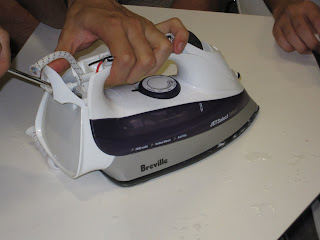
From our diassembly exercise, we found that household appliances such as these were in fact made for non-dissassembly. Many of the parts had to be forced apart in order to identify the various components as well as materials used.
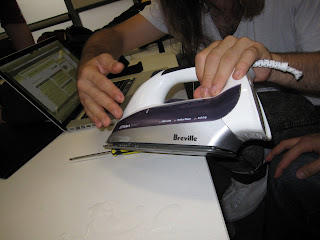


The final bit of this charette required our group to redesign the particular household appliance given to us. We ha to fulfill several criterias which included the reduction of materials used to manufacture the particular product and a streamlining of the original design.



From our diassembly exercise, we found that household appliances such as these were in fact made for non-dissassembly. Many of the parts had to be forced apart in order to identify the various components as well as materials used.
The final bit of this charette required our group to redesign the particular household appliance given to us. We ha to fulfill several criterias which included the reduction of materials used to manufacture the particular product and a streamlining of the original design.
Thursday, March 25, 2010
Charrete 1
For our first charrete session we were divided into groups and were tasked with finding solutions for an IKEA chair that were given to us. Here is a breakdown of solutions to those tasks.
The Ivar Chair given to our group.
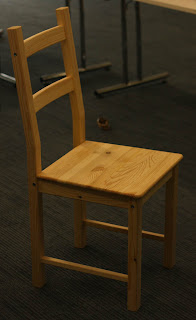
Our first task was a mind mapping session to various problems of the particular chair.

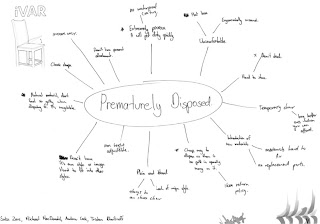
The following are several design solutions to problems related to the user.
1. Prolonged use of product

Several options of modification to the chair. These included interchangeable backing, steel-made replacements for the legs as well as interchangeable shapes for the seats.

Stack-able/modular solution to the chair which provides easier storage if users purchased several of the Ivar chairs.
 This solution focused on being able to fit a bag attachment. This can be used for extra storage space or be turned into a bin for rubbish.
This solution focused on being able to fit a bag attachment. This can be used for extra storage space or be turned into a bin for rubbish.
2. Physiological Pleasure after market parts

Various design considerations for physiological pleasure of users. Tarp finish and contoured finish seating modifications. Solid curved backing for comfort.
 Tarp attachment to replace wooden seat. Hooks on its side are to clip to the seating frame of the chair.
Tarp attachment to replace wooden seat. Hooks on its side are to clip to the seating frame of the chair.
3. Psychological/sociological after market attachments/products.
 Cushion padded sleeve to be placed over the back support of the chair.
Cushion padded sleeve to be placed over the back support of the chair.
 Height adjusting extension. To provide option to adjust height of seat. Top face fits underneath the chair.
Height adjusting extension. To provide option to adjust height of seat. Top face fits underneath the chair.
 Leg extender for chairs. With height provided, chair can now be used as a bar stool.
Leg extender for chairs. With height provided, chair can now be used as a bar stool.
A final modified design of the chair was then decided upon, and the following is the subsequent final design as well as a hero shot.


Storyboards we're also produced to illustrate the chair during the purchase process as well as its new modifications and new uses.
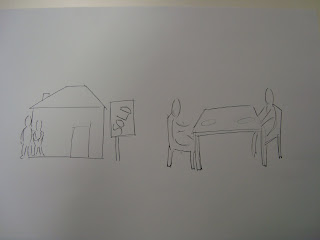

Thoughts on Final Design
For our final design, we decided for further physiological pleasure, we were to include our idea of a more comfortable backing as well as an improved curved finish to the original seat. Added to this was also the extra foot rest placed at the front bit of the chair frame. Wedges were also added to the front legs to have the chair rest at a more comfortable angle for the user. A further modification made to the chair was also the option to now be able to have extra storage space underneath the seat, similar to the storage space found in piano chairs.
Reflection
For this first charette exercise that we did, I found that our design capabilities were really tested with the format of quick and short periods given to come up with various solutions for the various design problems we had found. Coming up with a final solution at the end also allowed us to work together as a team, agreeing as well as disagreeing on design decisions. This would probably replicate a similar scenario in our future as designers, learning to be able to work with others to come up with a design solution. Overall, this charette was definitely helpful in exchanging ideas as well as working on our own in improving our pace and quality of our design.
The Ivar Chair given to our group.

Our first task was a mind mapping session to various problems of the particular chair.


The following are several design solutions to problems related to the user.
1. Prolonged use of product

Several options of modification to the chair. These included interchangeable backing, steel-made replacements for the legs as well as interchangeable shapes for the seats.

Stack-able/modular solution to the chair which provides easier storage if users purchased several of the Ivar chairs.
 This solution focused on being able to fit a bag attachment. This can be used for extra storage space or be turned into a bin for rubbish.
This solution focused on being able to fit a bag attachment. This can be used for extra storage space or be turned into a bin for rubbish.2. Physiological Pleasure after market parts

Various design considerations for physiological pleasure of users. Tarp finish and contoured finish seating modifications. Solid curved backing for comfort.
 Tarp attachment to replace wooden seat. Hooks on its side are to clip to the seating frame of the chair.
Tarp attachment to replace wooden seat. Hooks on its side are to clip to the seating frame of the chair.3. Psychological/sociological after market attachments/products.
 Cushion padded sleeve to be placed over the back support of the chair.
Cushion padded sleeve to be placed over the back support of the chair. Height adjusting extension. To provide option to adjust height of seat. Top face fits underneath the chair.
Height adjusting extension. To provide option to adjust height of seat. Top face fits underneath the chair. Leg extender for chairs. With height provided, chair can now be used as a bar stool.
Leg extender for chairs. With height provided, chair can now be used as a bar stool.A final modified design of the chair was then decided upon, and the following is the subsequent final design as well as a hero shot.


Storyboards we're also produced to illustrate the chair during the purchase process as well as its new modifications and new uses.
Thoughts on Final Design
For our final design, we decided for further physiological pleasure, we were to include our idea of a more comfortable backing as well as an improved curved finish to the original seat. Added to this was also the extra foot rest placed at the front bit of the chair frame. Wedges were also added to the front legs to have the chair rest at a more comfortable angle for the user. A further modification made to the chair was also the option to now be able to have extra storage space underneath the seat, similar to the storage space found in piano chairs.
Reflection
For this first charette exercise that we did, I found that our design capabilities were really tested with the format of quick and short periods given to come up with various solutions for the various design problems we had found. Coming up with a final solution at the end also allowed us to work together as a team, agreeing as well as disagreeing on design decisions. This would probably replicate a similar scenario in our future as designers, learning to be able to work with others to come up with a design solution. Overall, this charette was definitely helpful in exchanging ideas as well as working on our own in improving our pace and quality of our design.
Tuesday, March 16, 2010
"Every object tells a story, if you know how to read it" -Henry Ford
Objectified really opened my eyes to now view industrial design in a COMPLETELY new perspective. It reignited my passion in some ways showing me that there is so much more to design than just a uni course that I'm taking.
Andrew Blauvelt summarizes the phases of modern design in 3 steps. The first and most influential form of design is to design through form. A designers job in its essence is to give o product its form. To give it a reason for the product to look how it is meant to look. It might seem as an easy concept, but it actually requires a designer to think about the form of the design very thoroughly as every curve, every edge, every line gives a different meaning to the product.
Andrew continues on his thoughts of modern design by stating another phase of modern design being the symbolism which derives from a particular design. This means that the design of the product takes into consideration of things such as the cultural context the design might symbolize. This notion of symbolism then leads into the last phase of design that Andrew talks about, being the contextual aspects of design. An example would be to take the human-object relationship of a design into consideration.
Dieter Rams, a former design director for Braun lists what he thinks design should be during his segment in the video. Some of the most notable ones to me include his thoughts that good design is aesthetic design, is consistent in every detail, should be innovative and lastly, good design should be as little design as possible. Dieter really does a great job by summarizing what he thinks good design is and should be. It provides sort of a guideline that can be applied to our own process of design. He's calm and systematic approach to design really pushed me into wanting to implement this sort of mentality into my design process. After all, one isn't hired to be design director for one of the foremost design directed companies for doing a half-arsed job!
Another phrase That Rob Walker, a columnist and writer on design used in the video, was stating that designers strive in making products 0r designs that look 'now', look like products designed 'then', in order to have them purchase the 'new now' designs. I see this as a very bold and truthful statement in our current culture. People will always have a want for new things even though they own products that still perform tasks that they require. Humans have a need to follow current trends and purchase or replace their older products just because the products in which they own, are now viewed to be 'old'. But ironically enough, the video is summed up by Rob when he says that 'you keep products that tell the story of you'. How interesting that our culture has brought us up to constantly replace products we buy, but still, we as consumers, insist on keeping our old products for the memories that they can give us.
Objectified really opened my eyes to now view industrial design in a COMPLETELY new perspective. It reignited my passion in some ways showing me that there is so much more to design than just a uni course that I'm taking.
Andrew Blauvelt summarizes the phases of modern design in 3 steps. The first and most influential form of design is to design through form. A designers job in its essence is to give o product its form. To give it a reason for the product to look how it is meant to look. It might seem as an easy concept, but it actually requires a designer to think about the form of the design very thoroughly as every curve, every edge, every line gives a different meaning to the product.
Andrew continues on his thoughts of modern design by stating another phase of modern design being the symbolism which derives from a particular design. This means that the design of the product takes into consideration of things such as the cultural context the design might symbolize. This notion of symbolism then leads into the last phase of design that Andrew talks about, being the contextual aspects of design. An example would be to take the human-object relationship of a design into consideration.
Dieter Rams, a former design director for Braun lists what he thinks design should be during his segment in the video. Some of the most notable ones to me include his thoughts that good design is aesthetic design, is consistent in every detail, should be innovative and lastly, good design should be as little design as possible. Dieter really does a great job by summarizing what he thinks good design is and should be. It provides sort of a guideline that can be applied to our own process of design. He's calm and systematic approach to design really pushed me into wanting to implement this sort of mentality into my design process. After all, one isn't hired to be design director for one of the foremost design directed companies for doing a half-arsed job!
Another phrase That Rob Walker, a columnist and writer on design used in the video, was stating that designers strive in making products 0r designs that look 'now', look like products designed 'then', in order to have them purchase the 'new now' designs. I see this as a very bold and truthful statement in our current culture. People will always have a want for new things even though they own products that still perform tasks that they require. Humans have a need to follow current trends and purchase or replace their older products just because the products in which they own, are now viewed to be 'old'. But ironically enough, the video is summed up by Rob when he says that 'you keep products that tell the story of you'. How interesting that our culture has brought us up to constantly replace products we buy, but still, we as consumers, insist on keeping our old products for the memories that they can give us.
Saturday, March 13, 2010
Subscribe to:
Posts (Atom)






